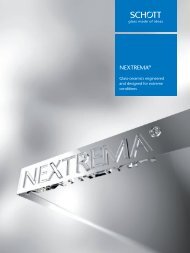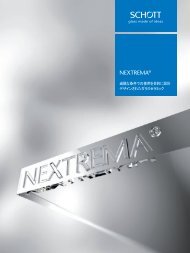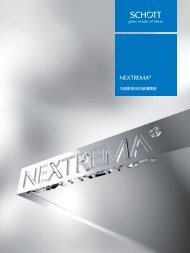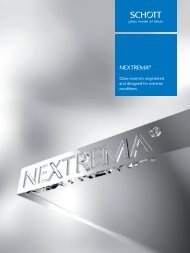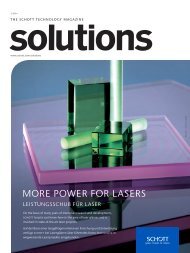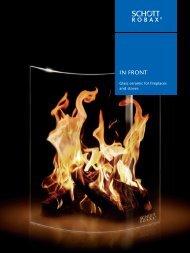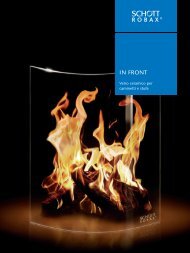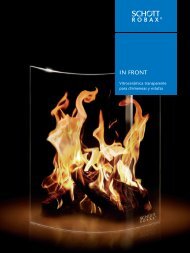SCHOTT Technical Glasses
Apart from its application in optics, glass as a technical material has exerted a formative influence on the development of important technological fields such as chemistry, pharmaceutics, automotive, optics, optoelectronics and information technology. SCHOTT Technical Glasses offers pertinent information in concise form. It contains general information for the determination and evaluation of important glass properties and also informs about specific chemical and physical characteristics and possible applications of the commercial technical glasses produced by SCHOTT. With this brochure, we hope to assist scientists, engineers, and designers in making the appropriate choice and make optimum use of SCHOTT products.
Apart from its application in optics, glass as a technical material has exerted a formative influence on the development of important technological fields such as chemistry, pharmaceutics, automotive, optics, optoelectronics and information technology. SCHOTT Technical Glasses offers pertinent information in concise form. It contains general information for the determination and evaluation of important glass properties and also informs about specific chemical and physical characteristics and possible applications of the commercial technical glasses produced by SCHOTT. With this brochure, we hope to assist scientists, engineers, and designers in making the appropriate choice and make optimum use of SCHOTT products.
You also want an ePaper? Increase the reach of your titles
YUMPU automatically turns print PDFs into web optimized ePapers that Google loves.
6<br />
1. Types of <strong>Technical</strong> <strong>Glasses</strong><br />
In the following, technical glasses are understood to be special<br />
glasses manufactured in the form of tubes, rods, hollow<br />
vessels and a variety of special shapes, as well as flat glass<br />
and glass powder for use mainly in chemistry, lab oratory<br />
technology, pharmaceuticals, optoelectronics, and household<br />
appliance technology.<br />
<strong>Glasses</strong> for purely optical applications are usually distinguished<br />
from these technical glasses by their special manufacturing<br />
processes and by their special compositional<br />
ranges.<br />
For the purposes of classification, the multitude of technical<br />
glasses can be roughly arranged in the following six groups,<br />
according to their oxide composition (in weight percent). It<br />
should be noted, however, that certain glasses fall between<br />
these groups, and others completely outside of the groups,<br />
and therefore cannot be classified as belonging to these<br />
types.<br />
Borosilicate glasses<br />
Characteristic of this type is the presence of substantial<br />
amounts of silica (SiO 2 ) and boric oxide (B 2 O 3 > 8 %) as glass<br />
network formers.<br />
The amount of boric oxide affects the glass properties in a<br />
particular way. Apart from the highly resistant varieties<br />
(B 2 O 3 up to a maximum of 13 %), there are others that – due<br />
to the different way in which the boric oxide is incorporated<br />
into the structural network – have only low chemical<br />
resistance (B 2 O 3 content over 15 %). Hence we differentiate<br />
between the following subtypes.<br />
Non-alkaline earth borosilicate glass<br />
(borosilicate glass 3.3)<br />
The B 2 O 3 content for borosilicate glass is typically 12 – 13 %<br />
and the SiO 2 content over 80 %. High chemical durability<br />
and low thermal expansion (3.3 x 10 –6 /K) – the lowest of all<br />
commercial glasses for large-scale technical applications –<br />
make this a multitalented glass material.<br />
High-grade <strong>SCHOTT</strong> borosilicate flat glasses are used in a<br />
wide variety of industries, mainly for technical applications<br />
that require either good thermal resistance, excellent chemical<br />
durability, or high light transmission in combination<br />
with a pristine surface quality.<br />
Other typical applications for different forms of borosilicate<br />
glass include glass tubing, glass piping, glass con tainers,<br />
etc. especially for the chemical industry.<br />
BOROFLOAT ® 33, SUPREMAX ® and DURAN ® belong to this<br />
glass family.<br />
Alkaline earth containing borosilicate glasses<br />
In addition to about 75 % SiO 2 and 8 – 12 % B 2 O 3 , these<br />
glasses contain up to 5 % alkaline earths and alumina<br />
(Al 2 O 3 ). To this subtype of slightly softer glasses (as compared<br />
with non-alkaline earth borosilicate glass), which<br />
have thermal expansion of between 4.0 – 5.0 x 10 –6 /K, belong<br />
the chemically highly resistant varieties FIOLAX ® 8412<br />
and 8414 (“neutral glasses”), and SUPRAX ® and 8488.<br />
High-borate borosilicate glasses<br />
<strong>Glasses</strong> containing 15 – 25 % B 2 O 3 , 65 – 70 % SiO 2 , and smaller<br />
amounts of alkalis and Al 2 O 3 as additional components, have<br />
low softening points and low thermal expansion. Sealability<br />
to metals in the expansion range of tungsten-molybdenum<br />
and high electrical insulation are their most important features.<br />
The increased B 2 O 3 content reduces the chemical resistance;<br />
in this respect, high-borate borosilicate glasses differ<br />
widely from non-alkaline earth and alkaline earth borosilicate<br />
glasses.<br />
Examples: 8245, 8250, 8337B, 8487.<br />
Aluminosilicate glasses<br />
Alkaline earth aluminosilicate glasses<br />
Characteristically, these glasses are free of alkali oxides and<br />
contain 15 – 25 % Al 2 O 3 , 52 – 60 % SiO 2 , and about 15 % alkaline<br />
earths. Very high transformation temperatures and<br />
softening points are typical features. Main fields of application<br />
are glass bulbs for halogen lamps, high-temperature<br />
thermometers, thermally and electrically highly loadable<br />
film resistors and combustion tubes.<br />
Examples: Halogen lamp glass types 8252 and 8253.<br />
Alkali aluminosilicate glasses<br />
The Al 2 O 3 content of alkali aluminosilicate glasses is typically<br />
10 – 25 % and the alkali content over 10 %. The high<br />
alkali content prepares the glass for ion exchange with<br />
bigger alkali ions in order to improve the surface compressive<br />
strength. High transformation temperatures and outstanding<br />
mechanical properties, e. g. hardness and scratch






